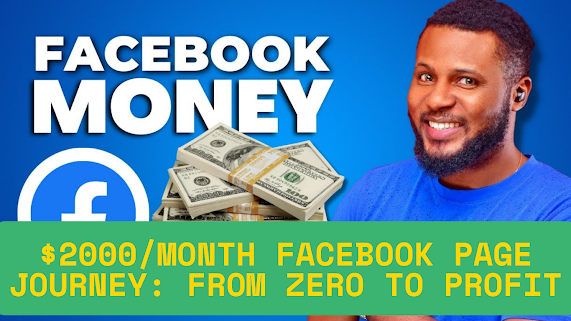$2000/Month Facebook Page Journey: From Zero to Profit
$2000/Month Facebook Page Journey: From Zero to Profit
===Best Automatic Earning Tools Free Download===
➡️ AI-Powered Marketing Tools Earning : Details Here
➡️ Instagram Marketing Automatic Software- Click Here
➡️ Writing Online Free Software : Download Now
➡️ Free PLR eBook - Success With Shopify : Click Here
➡️ Free PLR eBook - Video Marketing Mastery : Click Here
In today’s digital world, making money online is more than a dream—it's a real, achievable goal. Among the many platforms offering monetization opportunities, Facebook stands out as one of the most powerful. If you've ever wondered how to turn your Facebook page into a money-making machine, this article shares a real journey of building a Facebook page from scratch and growing it to $2000/month in revenue. Whether you're a beginner or looking to scale, this detailed guide will inspire and educate you.
The Beginning: Starting With Zero
Every successful journey starts with a single step. The Facebook page behind this journey was launched with zero followers, no prior audience, and minimal investment—just a clear vision and strong determination. The goal was simple: grow an engaged community and monetize the content effectively.
The niche chosen was news and viral content, a category that thrives on shares and engagement. The page focused on breaking news, trending stories, and relatable posts. Why news? Because it’s shareable, high-demand, and constantly updated, making it ideal for driving traffic.
Step 1: Choosing the Right Niche
Choosing the right niche is crucial for monetization. The focus was placed on:
-
News & Trending Topics – Constant flow of fresh content.
-
Relatable Local Content – Targeting audiences in countries with high CPM (Cost Per Mille), such as New Zealand, USA, and Canada.
-
Engaging Visuals – Posts with striking headlines and engaging images for higher reach.
SEO Tip: Use keywords like “Facebook page monetization,” “earn from Facebook,” and “social media income” in your posts and metadata for better visibility.
Step 2: Content Strategy for Growth
A strong content strategy played a key role in growing the page to over 100,000 followers in a few months. Here's how:
-
3-5 Posts Per Day: Posting consistently at peak times.
-
Mix of Content: News articles, memes, short videos, and quotes.
-
SEO Optimization: Using trending keywords in captions and hashtags.
-
Facebook Reels & Shorts: High-engagement format, particularly with viral clips.
Pro Tip: Analyze your Facebook Insights weekly to know what type of content your audience engages with most.
Step 3: Driving Traffic to Monetized Platforms
Once the Facebook page had a consistent stream of followers and engagement, the next step was to redirect that traffic to platforms that pay. Two main platforms were used:
1. Adsterra Ads (via Website Traffic)
The page owner created a simple blog website and connected it to Adsterra, a popular ad network. The Facebook page then shared click-worthy news articles, driving readers to the site.
-
Average CPM (New Zealand Traffic): $6–$10
-
Daily Visits: 5,000–10,000 from Facebook
-
Monthly Adsterra Revenue: ~$1200–$1500
Make sure your website loads fast, is mobile-friendly, and has quality content. Google-friendly websites retain traffic longer and improve ad earnings.
2. Affiliate Marketing Links
Products and services were promoted through affiliate links in posts. For example:
-
“Top 5 Budget Laptops – Buy Now”
-
“Best VPN Deals for 2025”
-
“Work-from-Home Essentials – Get Discounts”
Affiliate marketing contributed an additional $500–$800/month, especially during high-traffic seasons like Black Friday and Cyber Monday.
Step 4: Boosting Reach with Facebook Ads
Although the page started organically, small ad boosts were used strategically:
-
$5–$10 boosts on viral posts to reach wider audiences.
-
Targeting New Zealand, USA, and Canada for high-value traffic.
-
Retargeting people who engaged with past posts.
This resulted in a higher engagement rate, which organically improved page visibility and helped grow followers faster.
Step 5: Monetizing Facebook Videos
In the later stages, the page started uploading short-form videos (Facebook Reels) and eventually gained access to Facebook's in-stream ads program. This became another income source:
-
Video Views: 500,000–1,000,000 per month
-
In-Stream Ads Earnings: $300–$600/month (variable)
Short videos under 60 seconds with a strong hook and shareable message were the best performers.
Monthly Revenue Breakdown
| Source | Estimated Monthly Income |
|---|---|
| Adsterra (Website Ads) | $1200–$1500 |
| Affiliate Marketing | $500–$800 |
| Facebook Video Ads | $300–$600 |
| Total | $2000–$2900 |







.png)
